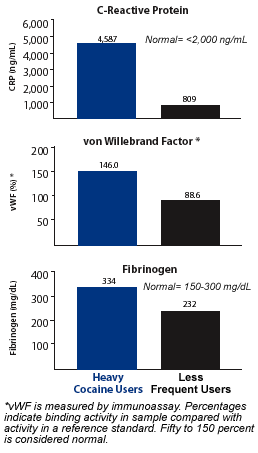Cocaine’s Effect on Blood Components May Be Linked to Heart Attack and Stroke
Download PDF Version What is PDF?
Patrick Zickler
Patrick Zickler is a Staff Writer for NIDA NOTES.
Source: NIDA NOTES, Vol. 17, No. 6, March, 2003
Public Domain
Table of Contents (TOC)
Article: Cocaine’s Effect on Blood Components May Be Linked to Heart Attack and StrokeReferences
Cocaine use increases the risk of sudden heart attack and may also trigger stroke, even in users who otherwise are not at high risk for these sometimes fatal cardiovascular events. The risk is related to narrowing of blood vessels and increases in blood pressure and heart rate. Recently, NIDA-supported researchers at the Alcohol and Drug Abuse Research Center at McLean Hospital in Belmont, Massachusetts, have identified changes in blood components that may also play a role in cocaine-related heart attack and stroke.
Key Blood Component Levels Are Higher in Heavy Cocaine Users
 Cocaine users who reported heavy use (6 to 20 times per week) show higher levels of C-reactive protein, von Willebrand factor, and fibrinogen--blood components that contribute to clotting--than do less frequent users (2 to 6 times per month).
Cocaine users who reported heavy use (6 to 20 times per week) show higher levels of C-reactive protein, von Willebrand factor, and fibrinogen--blood components that contribute to clotting--than do less frequent users (2 to 6 times per month).
Dr. Arthur Siegel and his colleagues studied the effect of cocaine on blood factors that respond to inflammation by promoting clotting to initiate repair. They found that a component that promotes clotting--von Willebrand factor (vWF)--increases and remains elevated for hours after a single exposure to cocaine. They also found that, compared with less frequent users, heavy users of cocaine have elevated levels of vWF, fibrinogen (a clotting factor), and C-reactive protein (CRP), a blood protein that increases in concentration in response to inflammation and is a reliable indicator of risk for heart attack.
"These findings suggest that cocaine creates a temporary risk for heart attack or stroke by increasing clotting factors," Dr. Siegel explains. "Elevated CRP levels could indicate that long-term use of the drug is triggering inflammation in the cardiovascular system."
Participants in the study were 20 individuals (10 women and 10 men, average age 26 years) who used cocaine 2 to 6 times per month but were drug free at the time of the study. They received injections of low (0.2 mg/kg) or moderate (0.4 mg/kg) doses of cocaine or of saline solution, and their clotting-related blood components were measured every 30 minutes for 4 hours. In participants who received moderate doses of cocaine, but not those receiving low-dose cocaine or saline, levels of vWF increased by roughly 40 percent and remained elevated for 4 hours.
"With healthy subjects, it’s not unusual to see a temporary increase in vWF after normal activity such as exercise," Dr. Siegel says. "But the increase is balanced by higher levels of factors that control clotting. The increases that followed cocaine administration were not accompanied by compensatory increases in protective factors."
 The researchers also compared the blood factor levels of
the original study participants to those of 10 other individuals
(6 women, 4 men, average age 41 years) who used the drug
far more heavily--6 to 20 times per week, on average--when
both groups were drug free. The heavy cocaine users had
higher levels of vWF, fibrinogen, and CRP.
The researchers also compared the blood factor levels of
the original study participants to those of 10 other individuals
(6 women, 4 men, average age 41 years) who used the drug
far more heavily--6 to 20 times per week, on average--when
both groups were drug free. The heavy cocaine users had
higher levels of vWF, fibrinogen, and CRP.
"Elevated levels of CRP and clotting factors that we see in the heavy users suggest that repeated use of cocaine poses an exposure-related and cumulative risk for heart attack or stroke," Dr. Siegel says. "The fact that neither group showed any compensatory increase in anticlotting mechanisms suggests that cocaine use upsets the body’s ability to maintain a balance between risk and protective factors and tips the scale toward increased risk for heart attack or stroke."
The findings are preliminary, Dr. Siegel cautions, and based on a relatively small sample of cocaine users. "Other factors certainly play a role in CRP levels, and cocaine alone is probably not responsible for the elevated levels we found. For example, age is a factor but does not account for all of the difference. Smoking also may be a factor. In our study, cocaine users who smoked had higher CRP levels than those who did not. On the whole, these findings suggest that cocaine compounds the effects of other risk factors."
If larger studies confirm the relationship between elevated CRP levels and cumulative cocaine exposure, the blood component may serve as a marker for damage, Dr. Siegel says. Moreover, he adds, "measuring CRP is simple and inexpensive, and could be used as a test for the effects of cocaine in much the same way as blood composition is used to test for diabetes. It could serve as an objective measure of risk for heart attack and stroke and provide a way for patients and treatment providers to assess progress during drug treatment."
Siegel, A.J., et al. Cocaine-induced erythrocytosis and increase in von Willebrand factor. Archives of Internal Medicine 159:1925-1930, 1999.
Siegel, A.J., et al. Effect of cocaine usage on C-reactive protein, von Willebrand factor, and fibrinogen. American Journal of Cardiology 89:1133-1135, 2002.


